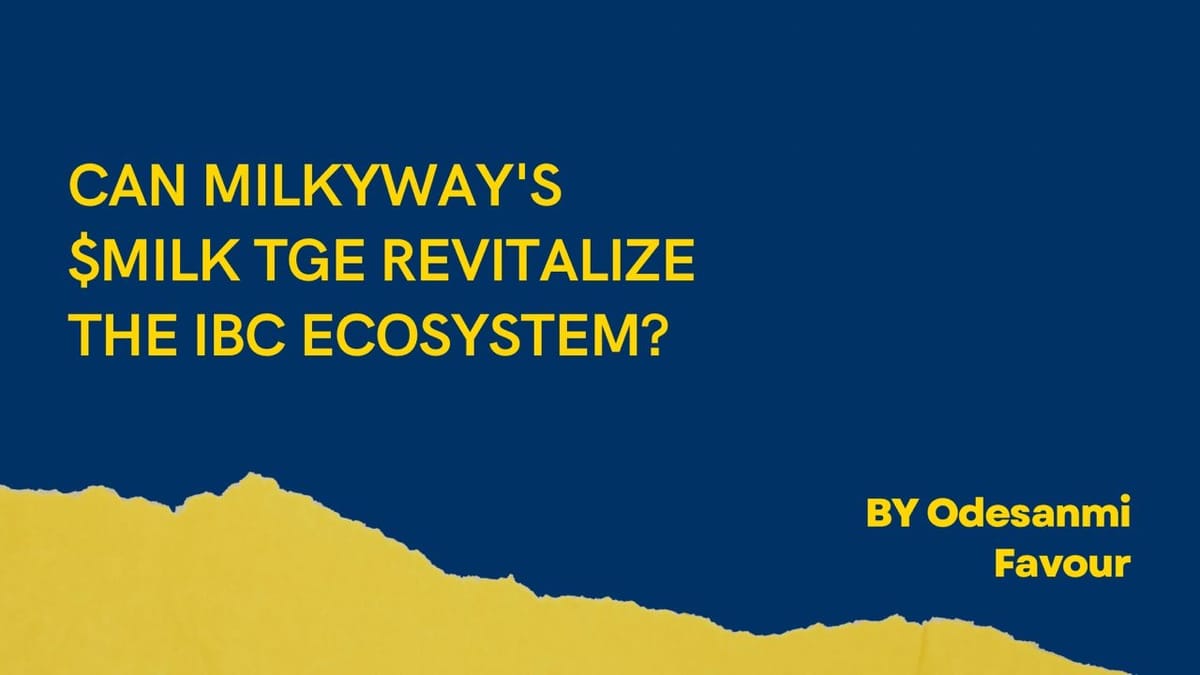Can MilkyWay’s $MILK TGE Revitalize the IBC Ecosystem?

Introduction
The Inter-Blockchain Communication (IBC) protocol, a cornerstone of the Cosmos ecosystem, enables seamless data and asset transfers across independent blockchains. Despite its technical prowess, the IBC ecosystem has faced challenges in maintaining momentum amid competition from Ethereum’s Layer 2 solutions and high-performance chains like Solana. The Token Generation Event (TGE) for MilkyWay’s $MILK token, launched on April 29, 2025, via Binance Wallet and PancakeSwap, has sparked discussions about its potential to reinvigorate IBC. As the leading liquid staking and restaking protocol for modular blockchains like Celestia and Initia, MilkyWay’s $MILK TGE could drive liquidity, enhance cross-chain security, and foster ecosystem growth.
In this article, we would explore:
1. Boosting Liquidity and DeFi Integration in the IBC Ecosystem
2. Enhancing Cross-Chain Security Through Restaking
3. Driving Community Engagement and Governance
Boosting Liquidity and DeFi Integration in the IBC Ecosystem
MilkyWay’s $MILK TGE introduces a native token designed to power its liquid staking and restaking platform, significantly enhancing liquidity within the IBC ecosystem. By enabling stakers to receive liquid staking derivatives (LSDs) like milkTIA and milkINIT, MilkyWay unlocks capital efficiency, allowing users to utilize staked assets across DeFi protocols. With a total value locked (TVL) of $190 million and integrations with over 10 DeFi platforms, including Osmosis, Levana, and Mars, the TGE could catalyze broader adoption of IBC-connected chains.
Key Impacts
1. Liquid Staking Derivatives (LSDs): Stakers of TIA (Celestia) or INIT (Initia) receive milkTIA or milkINIT, which can be used for trading, lending, or yield farming on IBC-compatible platforms like Osmosis and Demex. This flexibility contrasts with traditional staking, where assets are locked, and could attract more users to IBC chains. For example, a user staking TIA on MilkyWay can lend milkTIA on Mars Protocol to earn additional yields, increasing capital circulation within Cosmos.
2. TGE and Airdrop Effects: The TGE allocated 20 million MILK tokens (2% of the 1 billion total supply) via Binance Wallet, with another 100 million (10%) airdropped to early supporters like mPoint holders and Moolitia NFT owners. This distribution incentivizes participation and drives trading volume, as seen with $MILK’s 24-hour trading volume of $24.1 million post-launch. Increased liquidity on exchanges like Bybit and MEXC could strengthen IBC’s DeFi ecosystem.
3. Cross-Chain Interoperability: MilkyWay’s focus on chain abstraction simplifies asset movement across IBC chains, reducing user friction. For instance, milkTIA can be bridged to Dymension or Arbitrum’s Camelot DEX, creating new liquidity pools and attracting DeFi users to IBC.
For Example: A DeFi user stakes 1,000 TIA on MilkyWay, receiving milkTIA. They add milkTIA to an Osmosis liquidity pool, earning 15% APY in trading fees while retaining TIA staking rewards. This dual-yield strategy, enabled by $MILK’s ecosystem, draws more liquidity to Osmosis, boosting IBC’s DeFi prominence.
Challenges
While MilkyWay’s integrations are promising, competition from Ethereum’s L2s, which boast lower fees and larger user bases, could limit IBC’s DeFi revival. MilkyWay must continue expanding partnerships to maintain momentum.
Enhancing Cross-Chain Security Through Restaking
MilkyWay’s restaking protocol addresses the fragmentation of security in modular blockchains, a critical challenge for IBC’s scalability. By allowing staked assets to secure multiple Actively Validated Services (AVSs) like oracles, bridges, and rollups, $MILK’s TGE could unify trust across IBC chains, making the ecosystem more robust and attractive to developers and users.
Key Impacts
1. Restaking Mechanism: Users can restake LSDs (e.g., milkTIA) to secure external services, earning additional rewards without locking more capital. For example, a staker can delegate milkTIA to secure a rollup sequencer on Initia, enhancing network security while earning restaking yields. This reduces the need for each IBC chain to bootstrap its own validator set, lowering costs and improving efficiency.
2. Permissionless Restaking: MilkyWay’s permissionless protocol allows third parties to build liquid restaking services, fostering innovation. The Inertia team, for instance, is developing new liquid restaking tokens (LRTs), which could expand IBC’s security infrastructure.
3. TGE Incentives: The TGE’s allocation of 165 million MILK tokens (16.5%) for AVS integrations and developer grants incentivizes projects to adopt MilkyWay’s restaking model. This could lead to more IBC chains leveraging shared security, strengthening the ecosystem’s resilience.
For Example: A developer building a rollup on Initia uses MilkyWay’s restaking to secure it with milkINIT, avoiding the cost of creating a new validator set. Stakers earn 5% APY for restaking, attracting more validators to Initia and enhancing IBC’s modular ecosystem.
Challenges
Restaking introduces slashing risks, as staked assets are exposed to multiple services. MilkyWay’s advanced slash logic, built on Cosmos SDK, mitigates this, but user education and robust auditing are essential to maintain trust.
Driving Community Engagement and Governance
The $MILK TGE empowers the MilkyWay community to shape the IBC ecosystem through governance and incentivized participation. With $MILK as the governance token, holders can vote on protocol upgrades, AVS integrations, and ecosystem grants, fostering a decentralized and engaged community that could revive IBC’s collaborative spirit.
Key Impacts
1. Governance Power: $MILK holders can propose and vote on ecosystem decisions, such as expanding to new chains like Babylon or adjusting protocol fees (10% of milkTIA rewards go to $MILK stakers). This aligns incentives and encourages long-term commitment. For example, a community vote could prioritize integrating milkBABY with Babylon, boosting IBC’s interoperability.
2. Airdrop and mPoints System: The 100 million MILK airdrop and mPoints system reward early adopters and active users, driving engagement. Participants who staked TIA since December 2023 or contributed to milkINIT testing received airdrops, creating a loyal user base. This mirrors successful Cosmos airdrops like Osmosis, which boosted community growth.
3. Market Sentiment: Posts on X highlight bullish sentiment, with users viewing $MILK as a catalyst for IBC’s revival due to its innovative staking model. The TGE’s listing on major exchanges like MEXC and Bybit, coupled with Osmosis’s support as a trading venue, amplifies visibility and attracts new users to IBC.
For Example: A $MILK holder with 10,000 tokens votes to allocate developer grants for a new IBC bridge to Polkadot, enhancing cross-ecosystem connectivity. Their staking rewards from protocol fees (e.g., 0.5% of milkTIA yields) incentivize continued participation, strengthening IBC’s community-driven ethos.
Challenges
Governance apathy could hinder progress if $MILK holders don’t actively participate. Additionally, the token’s price volatility (down 8.7% in 24 hours post-TGE to $0.1159) may deter speculative investors, though long-term utility could stabilize value.
Conclusion
MilkyWay’s $MILK TGE, launched on April 29, 2025, holds significant potential to revitalize the IBC ecosystem by boosting liquidity, enhancing cross-chain security, and driving community engagement. The protocol’s liquid staking and restaking innovations, backed by a $190 million TVL and integrations with key DeFi platforms, position it as a catalyst for IBC’s DeFi resurgence. Restaking unifies security across modular chains, reducing fragmentation and attracting developers, while $MILK’s governance empowers a vibrant community to shape the ecosystem’s future. However, challenges like competition from Ethereum L2s, restaking risks, and governance participation must be addressed to sustain momentum.
As IBC navigates a competitive blockchain landscape, MilkyWay’s $MILK TGE could be a turning point, leveraging Cosmos’s interoperability strengths to reclaim market relevance. Stakeholders should monitor adoption metrics, such as TVL growth and AVS integrations, to gauge its impact. By fostering collaboration and innovation, MilkyWay could indeed reignite the IBC ecosystem’s spark, paving the way for a modular, interconnected future.



Comments ()